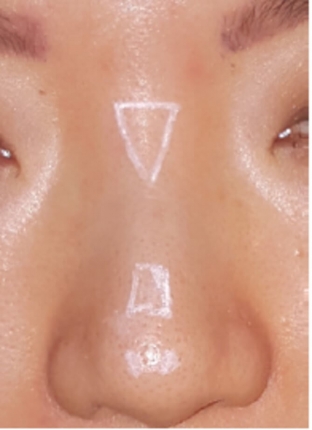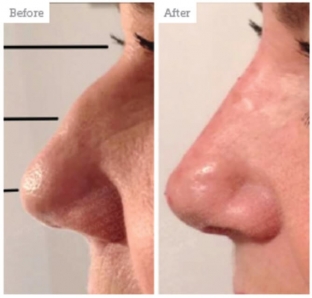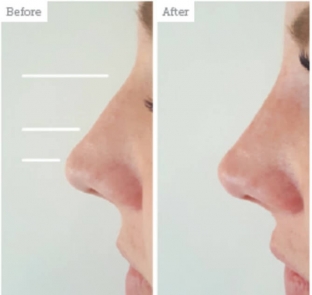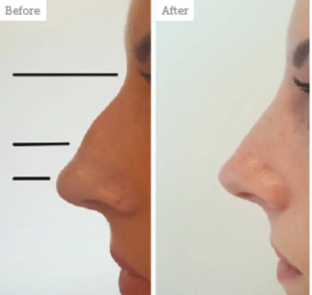Non-surgical rhinoplasty – a popular procedure that allows you to correct minor aesthetic imperfections, such as saddle deformity, humpback or disproportionate nose. In some cases, injection rhinoplasty can be an excellent addition to nose surgery. There are many techniques for this procedure, which allow you to get excellent results. However, the physician must always take into account the limitations and contraindications to their use, as well as potential risks and errors. This article describes the protocol for 3-point non-surgical rhinoplasty using hyaluronic acid fillers. This technique is safe, reliable and effective, and reduces the risk of side effects.
Three-point technique for non-surgical rhinoplasty: the essence of the methodThree-point rhinoplasty is performed to correct the most typical aesthetic imperfections of the nose in patients – low-lying root, hump on the back and insufficient projection of the tip of the nose.
The author of the above method of non-surgical rhinoplasty – Dr. Ayad Harb – applied the three-point technique on 148 patients with excellent results.

Fig. 1: three anatomical points and filler injection sites
Benefits of 3-point non-surgical rhinoplasty for patients:
- the procedure takes only 15 minutes and is performed on an outpatient basis;
- the procedure is painless and does not require the introduction of an anesthetic;
- the procedure involves minimal risk to the patient;
- no scars left after the procedure;
- no recovery period;
- result is noticeable immediately after the procedure.
Three-point rhinoplasty is performed to systematically correct the most typical aesthetic imperfections of the nose in patients – low-lying root, hump on the back and insufficient projection of the tip of the nose.There is also a category of patients for whom surgery is contraindicated for medical reasons or is not suitable for personal reasons. In such cases, non-surgical rhinoplasty can be an excellent way to correct the nose according to the wishes of the patient.
Also suitable for patients who are considering
surgical rhinoplasty and want to see what their "new nose" will look like. before the surgical procedure.
Benefits of 3-Point Injection Rhinoplasty for the Physician:
- relative ease of procedure;
- no need for multiple drug administration;
- no need to re-correct to improve the results (if the procedure was carried out correctly).
3-Point Non-Surgical Rhinoplasty Technique
After the consultation and informed consent is obtained from the patient, the patient is prepared for the procedure. The doctor marks three anatomical points and insertion zones (Fig. 1): at the root of the nose, at the hump on the back of the nose and at the tip of the nose.
Anesthetic creams can be used for the procedure, however, it must be remembered that this increases the risk of swelling, irritation and bleeding in the insertion test, which can disrupt the contours that require correction.
To avoid the need for additional anesthetics that can distort and mask subtle nasal deformities, hyaluronic acid fillers with lidocaine should be selected for non-surgical rhinoplasty. The ideal filler for this procedure – viscous gel based on cross-linked hyaluronic acid, which is characterized by long-lasting action and the ability to volumise.
Three-point injectable rhinoplasty is most often done with a needle.The introduction of the drug is carried out with a minimum number of penetrations – ideally, the needle is inserted only three times. The essence of the 3-point technique is to work with three important anatomical points on the nose, in this case the number 3 does not mean the number of injections – in some cases, with insufficient correction, it may be necessary to re-inject the drug at certain points.
The principle of non-surgical, as well as surgical, rhinoplasty is to cause minimal damage to soft tissues and, accordingly, reduce pain, swelling and scarring. Therefore, it is better to use a needle to administer the drug (Fig. 2, 3 and 4).
An inert hyaluronic acid filler should be used, which causes minimal tissue reaction and swelling. During non-surgical nose correction, the introduction of drugs that stimulate the production of collagen, and other bioactive semi-permanent fillers, which can provoke an increase in collagen synthesis and scarring, should be avoided. For this technique, the author injects the drug with a needle; however, there are other cases where it is necessary to use the – when correcting a deviated septum of the nose. In most cases, the author does not recommend the use of cannula techniques in order to avoid repeated trauma and potential scarring of the soft tissues of the nose.

Fig. 2: Left: The first insertion point at the root of the nose allows you to lift this area of the nose, giving it a more aesthetic appearance, as well as to form a beautiful curve between the nose and between the eyebrows.
Fig. 3: Center: a second insertion point at the bridge of the nose helps to mask a visible bump or depression on the bridge of the nose.
Fig. 4: Right: The third insertion point at the tip of the nose allows you to correct the light reflection points on the tip of the nose and lift it.
It is important to minimize interference with the anatomy of the nose – this will reduce puffiness, shorten the recovery period and get natural results. Factors that can contribute to excessive tissue swelling and bruising, making the procedure more difficult and less predictable:
- multiple insertion points;
- multiple correction;
- "rough" insertion technique;
- use of low quality HA fillers.

Fig. 5 Before and after non-surgical 3-point rhinoplasty
It is also very important to reduce scarring by minimizing the amount of localized tissue damage, particularly in patients who may consider future surgical rhinoplasty, as disruption of tissue planes and additional scarring can complicate the operation.Compared to other similar techniques, 3-point non-surgical rhinoplasty overcomes these barriers by using only three critical injection points, which provide excellent results for most patients.
Introduction Points for 3-Point Non-Surgical Rhinoplasty
HA-based fillers are administered using the 3-point non-surgical rhinoplasty technique in:
- a point at the root of the nose;
- dot on the back of the nose;
- point on the tip of the nose.
The filler is injected at the root of the nose and the hard part of its back, after which it is distributed with fan-shaped massage movements that taper towards the hump of the nose. The purpose of this point is to raise the level of the root of the nose to the lash line to create more harmonious proportions and smooth out the too wide lower part of the nose. The fan-shaped distribution also emphasizes the slight curve between the nose and between the eyebrows. Introduction closer to the hump of the nose allows you to visually reduce it.
Introduction Point #2 – on the back of the nose
HA filler is injected as a small bolus directly in front of and behind the prominent nasal hump. After that, the HA is gently distributed with massage movements to reduce the severity of the hump and smooth out the uneven contour of the back, slightly directing the material to the lower third of the nose.
Introduction Point #3 – at the tip of the nose
A small amount of HA is injected into the two reflective points at the tip of the nose. The volume of the injected drug varies from 0.05 to 0.1 ml and depends on the shape of the nasal tip and the soft tissue response to the filler injection. This helps lift the tip of the nose slightly and create a slight supra-tip kink that is more aesthetically pleasing than a perfectly straight profile, especially in women.
Ideal patient for 3-point non-surgical rhinoplasty
3-point non-surgical rhinoplasty – a versatile technique that can be applied to a wide range of patients. The ideal patient should have realistic expectations for results after a non-surgical procedure.
Patients with a slight dorsal bulge or hump, low root, and poor nasal tip projection are ideal candidates for non-surgical correction using the described 3-point technique. It is important to explain to the patient that as a result of the filler, the nose will become larger, but this will not be visually noticeable. Thanks to the proportionality, alignment of the profile and the rise of the tip, the nose will look more harmonious.
Patients with a slight dorsal bulge or hump, a low root, and poor nasal tip projection are ideal candidates for non-surgical correction.

Fig. 6 Before and after non-surgical rhinoplasty using the 3-point technique
What results can I expect after a non-surgical 3-point rhinoplastyThe results obtained with the 3-point non-surgical rhinoplasty technique, with proper patient selection, minimal anatomical intervention, and the use of a small amount of high-quality HA filler, are extremely reliable and reproducible.
The duration of the effect depends on the type of filler used, as well as the individual patient, such as the level of physical activity and metabolic rate. As a rule, the results after 3-point and any other non-surgical rhinoplasty with hyaluronic acid fillers are maintained for 9-12 months.

Fig. 7 Before and after non-surgical 3-point rhinoplasty
As a rule, the results after 3-point and any other non-surgical rhinoplasty with hyaluronic acid fillers are maintained for 9-12 months.3-point non-surgical rhinoplasty: possible risks and complications
Like any other procedure, 3-point non-surgical rhinoplasty comes with potential side effects and complications. They include:
- impaired blood circulation if the filler is not injected properly or if the skin is subjected to excessive stress;
- Abnormal contours of the nose, visible or palpable boluses, or large volumes of filler in the case of a patient who should have been referred for surgical rhinoplasty.
hyaluronidase.
Despite its extreme rarity, blindness after non-surgical rhinoplasty remains a serious risk that the patient should always be informed about.This risk can be minimized by deep injection closer to the bone, a minimum number of injections, slow administration and knowledge of the anatomy of the nose.
Among other risks associated with injection, the author lists:
- bleeding;
- bruises;
- pain;
- infections.
Contraindications for 3-point non-surgical rhinoplasty
Typical contraindications for dermal fillers, which are also used for non-surgical rhinoplasty, include:
- skin diseases in acute or chronic form;
- pregnancy;
- breastfeeding;
- allergic reactions or intolerance to the components of the dermal filler.
Problems can also result from:
- injuries;
- preliminary surgery;
- excessive thinness of the skin;
- unrealistic patient expectations.
Read also:
Injectable rhinoplasty: important success rules to follow
Three-point technique of non-surgical rhinoplasty is a simplified and rationalized method for correcting the most common deformities in the nose area – too low root of the nose, the presence of a hump, insufficient projection of the tip of the nose. This method allows you to get excellent results with minimal risk of swelling and scarring.Adapted from Aesthetics.







Add a comment